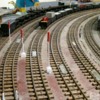Originally Posted by Jtrain:
Does anyone make Code 172 2-rail track? I think that is the lowest scale profile height that will work with all 3-rail wheel flanges. Others have tested Code 148 track and found that some 3-rail wheel flanges touch the ties, but maybe I am misremembering.
All that we really need is a manufacturer to make the center rail. If it is made with blackened material, it would be pretty much invisible except from a few inches away. Even then, it would appear as simulated oil drip spots between the rails. The center stud rail could be used with existing 2-rail track. Turnouts seem to be a complication, however. The clip on "skis" would seem easy enough.
Add scale sized electro-couplers for locomotives, maybe kadees for rolling stock, and all that is really left are scale pilots for diesel locomotives and coupler related details, in some cases. Most of the 2-rail pilots for diesels that I have seen from Weaver and Atlas could be done much better. Perhaps 3D printing is the answer for prototypically accurate scale pilots?
My goal in all this is to have something that looks just like 2-rail scale but to be able to buy and use the much greater and usually less expensive variety of 3-rail locomotives and rolling stock, without needing to convert anything other than relatively minor modifications. 2-rai l rolling stock could also be used unmodified. It seems there are others out there who share this goal.
Jtrain,
It's interesting you mention code 172 track- back in the 40s and 50s, most 2-rail O gaugers used code 172 solid rail, with handlaid ties and spikes. The oversized rail profile common now was no doubt due to different manufacturers attempting to match the height of classic 0 and then 0-27 Lionel track, but then realizing it was too tall and toylike to look realistic.
As far as attempting to disguise or minimize the center rail, this is nothing new- Gargraves has had a darkened center "phantom" rail for 50+ years. Atlas 3-rail also has a darkened center rail, but many have had issues with conductivity on the center rail, and just sanded or polished the coating off the top of the rail. MTH's Scaletrax has a narrow, darkened center rail, realistic tie plates, and a lower profile rail. All of these track systems attempt to hide the center rail, but IMO it's still there and obvious to me- only studrail allows 3-rail trains to run on 2-rail track. The studrail treatment can also be done to all three of these track systems, making them look even more realistic. Of course many 3-railers prefer the RTR nature of existing 3-rail track systems.
I've attempted to run some of my 3-rail engines on Atlas code 148 track- the Lionel engines in particular had flanges that were too tall, and hit the ties. The Atlas, MTH, and even K-Line 3-rail engines have smaller flanges and work better on code 148 track, but the taller flanges still cause the engines to jump over the frogs on switches. The best scenario is an 3-rail engine that can be retrofitted with scale wheels, like the MTH 3/2 Protoscale and Atlas diesels.
I do agree It's better to buy diesels with fixed pilots and scale wheels, like the MTH 3/2 Protoscale engines, but I'm not opposed to converting 3-rail versions with hi-rail wheels. O gauge 3-railers have gotten used to pulling RTR engines out of the box and running them, but if I can buy slightly used engines at a good price and convert them to fixed pilots, scale couplers and wheels, I'll do it. I started in 3-rail O scale over 25+ years ago- I'm converting the engines and rolling stock I like, selling off the rest and buying newer equipment as I go. It involves some work, but is a much more cost- effective means of getting the trains I want.
Geno






